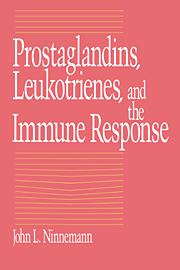Book contents
- Frontmatter
- Contents
- Foreword by James S. Goodwin
- Preface
- 1 A brief history and introduction
- 2 Prostaglandin/leukotriene structure and chemistry: a primer
- 3 Monocytes and macrophages
- 4 Lymphocyte response
- 5 Inflammation and the neutrophil
- 6 Malignancy and the arachidonic acid cascade
- 7 Tissue and organ transplantation
- 8 Rheumatoid arthritis and autoimmunity
- 9 Traumatic injury and surgery
- 10 Allergy
- Index
Foreword by James S. Goodwin
Published online by Cambridge University Press: 24 November 2009
- Frontmatter
- Contents
- Foreword by James S. Goodwin
- Preface
- 1 A brief history and introduction
- 2 Prostaglandin/leukotriene structure and chemistry: a primer
- 3 Monocytes and macrophages
- 4 Lymphocyte response
- 5 Inflammation and the neutrophil
- 6 Malignancy and the arachidonic acid cascade
- 7 Tissue and organ transplantation
- 8 Rheumatoid arthritis and autoimmunity
- 9 Traumatic injury and surgery
- 10 Allergy
- Index
Summary
Single-author books are becoming somewhat of a rarity in scientific literature. Far more common are the multiauthored loosely edited works focused on a single topic. Such publications have their uses, especially in giving the reader first-hand accounts of relevant research findings. On the other hand, multiauthored works frequently fail when it comes to providing a synthesis, an overall picture of a complex field, wherein seemingly unrelated findings are placed in the “big picture”. This is an important goal for any scientific book, especially one devoted to a field as rife with seemingly contradictory data as is the area of eicosanoids and immune function. Dr. Ninnemann succeeds admirably in meeting this goal. He has managed to integrate into a readable text an enormous amount of data, results obtained in vitro and in vivo in animals and in humans.
How important are arachidonic acid metabolites in the normal immune response? We assume that cyclooxygenase metabolites are not critical for normal functioning, because both humans and animals seem to do quite well on long-term treatment with cyclooxygenase inhibitors. On the other hand, overproduction of cyclooxygenase metabolites and/or changes in sensitivity to these metabolites would appear to play a role in the disturbances in immunoregulation associated with several diseases. Less is known about the role of the lipoxygenase metabolites of arachidonic acid, but it is clear that one or more of these lipoxygenase metabolites must play an important role in normal immune function, because all the lipoxygenase inhibitors recently developed are powerful immunosuppressants.
- Type
- Chapter
- Information
- Publisher: Cambridge University PressPrint publication year: 1988



